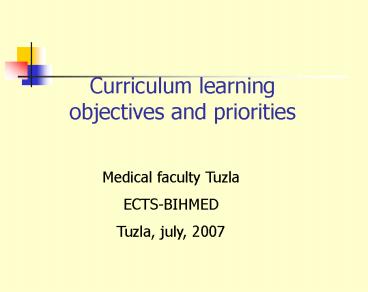Curriculum learning objectives and priorities PowerPoint PPT Presentation
1 / 18
Title: Curriculum learning objectives and priorities
1
Curriculum learning objectives and priorities
Medical faculty Tuzla ECTS-BIHMED Tuzla, july,
2007
2
Structure of Program
- Divided in six academic years
- First year is basic biomedical study
- Second year is basic medical study
- Third year is diagnostic and molecular medicine
- Forth sixth years include different Clinical
subjects- Internal medicine, Surgery, Public
Health.
3
Learning objectives of curriculum program
- Gives competence for working as physicians
- Give competnece for research work and for
administrative duties which require medical
expertise - To prepare student for post graduate study
4
Learning objectives of Basic study
- Basic knowledge about physical and inorganic
chemistry which are important for understanding
structure of chemistry and chemical reactions of
biological important compounds. - Basic knowledge about puffers, thermo chemistry
and bioenergetics and physical-chemical
processes, important for keeping live, Organic
and Bioorganic Molecules.
5
Learning objectives of Basic study
- Knowledge about physical laws, methods and
technique in physic and physico chemical
properties of the biology systems and influence
of external factors on them, physical principles
of the structure and function of the human
organism, physical methods for diagnostics and
medical treatment.
6
Learning objectives of Basic study
- Introducing of students with organisation and
structure of cell, cell organella on molecular
level, morphologic and molecular structure of
chromosomas, structure of nucleic acids,
structure and function of genes and genetic
control og growth. - Introducing of student with the basic principles
of inheritance in human genetic, analysis of
human genome, congenital diseases caused by gene
and chromosomal mutation, basic principles of
immuno genetic, ecogenetic and human population
genetic.
7
Learning objectives of Basic study
- To understand and accept the basic principles of
structure and function of living matter - Understand metabolism conservation of energy,
synthesis and degradation of major cellular
components and integration of these pathways in
human including clinical correlations and
biochemistry of disease .
8
Learning objectives of Basic medical study-
Morphology and function
- Macroscopic morphology of the Human body
- Celular, tissue and organ microscopic morphology
- Basic human physiological mechanisms and control
systems.
9
Learning objectives of Diagnostic
- General knowledge about basic process in cell and
tissue in specific organ tract disease. - To learn the basic principles of medical
bacteriology, mycology, parasitology, virology
and immunology. The main emphasis is on
molecular, cellular and pathogenetic aspects, but
also diagnostic, therapeutic and epidemiological
issues are included. Students will practise basic
diagnostic techniques.
10
Learning objectives of Diagnostics
- Teach students to integrate different preclinical
knowledge. To introduce them with
pathophysiologic events of diseases from the
basic level (tissues and organs) to the whole
organism - To introduce the students with importance and
possibilities of the radiological methods in
clinical medicine
11
Learning objectives Clinical study
- Give knowledge and skills about management of
patients with internal diseases, infectious
disease, and dermatovenerical disease - To give basic knowledge about neurological
propedeutic, basic neurology and common diseases
of the nervous system (etiology, patophysiology,
clinical symptoms and signs, diagnosis, therapy
and rehabilitation). - To give knowledge in biological, psychological
and social factors in the assessment and
treatment mental illness and practical
application of psychiatric treatments
12
Learning objectives Clinical study
- Give knowledge, skills and positions
(communications) in pharmacology and toxicology.
Student must learn general principles in
pharmacology, mechanisms of drug acting, adverse
drug reactions. - To give basic knowledge about genesis, nature,
diagnostics and treatment of malignant tumours.
13
Learning objectives Clinical study
- Qualify students to diagnose, treat and prevent
illnesses of childhood as well as restoring of
damaged functions. - Basic education in general surgery, orthopedic
surgery and traumatology. Principles of surgical
care - To give basic knowledge about gynaecological
physiology, gynaecological illnesses in different
ages and gynaecological oncological illnesses. - To give basic knowledge about pregnancy, seeknes
in pregnancy and normal labour as possible
complications and approaches.
14
Learning objectives Clinical study
- Give students knowledge about diseases of ear,
nose, throat and head and neck, diagnostic and
therapy - to provide the trainee with a systematic and
easily assimilated introduction to ophthalmology
- Training in emergency health care
15
Learning objectives Clinical study
- Effective communication skills
- Ccompetency in clinical skills and minor
procedures - Ability in problem formulation and problem
solving - Ability to develop management plans for common
problems
16
Learning objectives Public Helath
- Introduction to ecologic content and hygienic
conditions which determinate health situation of
an individual or the population. - Health aspects of occupational health
- Relationship between risks of working
environment and health effects - Differential diagnosis occupational diseases and
work related diseases - Increase knowledge in the area of occupational
and environmental toxicology
17
Learning objectives Public Helath
- Being introduced with the organisation of health
protection in our country and in the world,
introduction to health legislative, financing of
health, health problems of public importance,
health information system, health promotion and
planning and programming of health protection and
evaluation. - Basics knowledge of forensic medicine and its
application in praxis
18
Learning objectives
- To develop students awareness of the function of
communications and to increase students knowledge
about the communication, and to enhance students
communicative competence - To qualify students for basic medical research,
writing and publishing paper.

